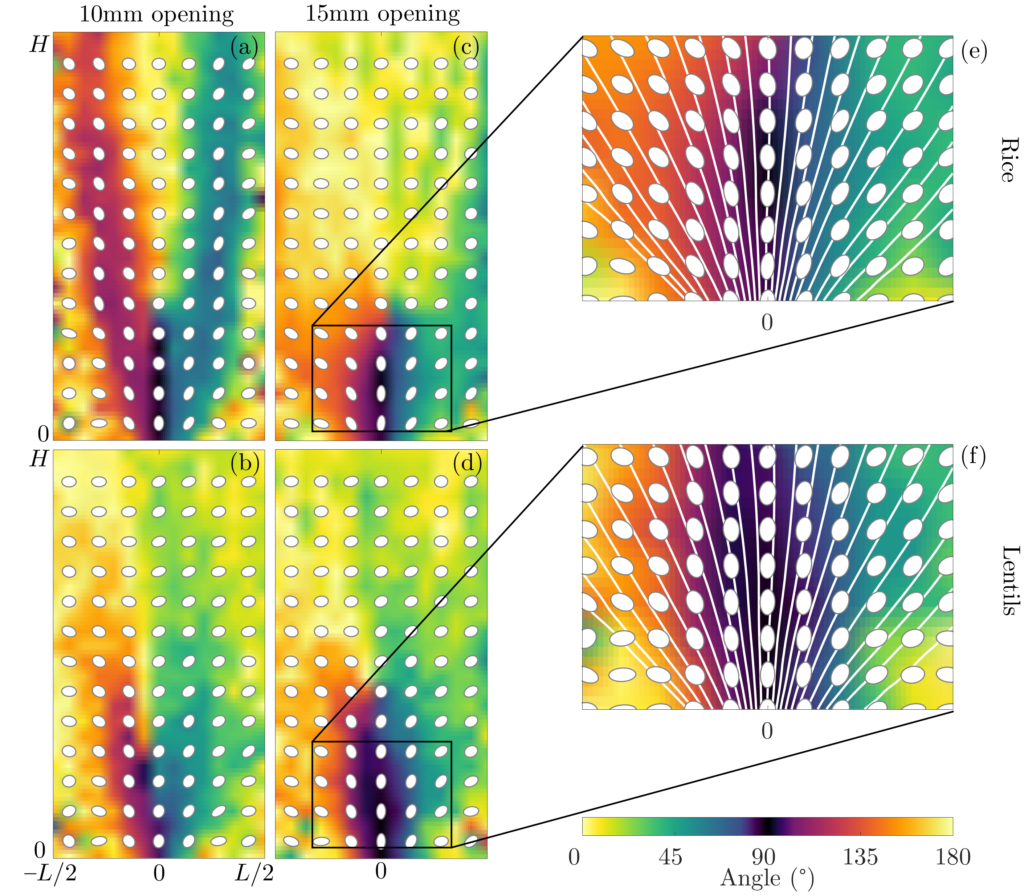Not all granular materials are made of round particles. In particular, grains may be elongated, like rice grains, logs, or pharmaceutical pills. Such elongated grains have different properties when flowing.
Flow of rice and lentils down a silo, observed in X-ray radiography.
We experimentally study the flow of non-spherical particles down a silo. Using X-ray radiography in order to see through the material, we can see that round grains (glass beads) and elongated grains (rice) behave fairly differently:
To quantify the degree of alignment of the grains with the flow, we developed several techniques to measure the velocity and orientation of the granular material directly from the dynamic radiographs.

patches of 64 × 64 pixels are extracted from a radiograph, (b) multiplied by a circular Hamming window, and
(c) processed by a two-dimensional Fourier transform, leading to the power spectrum of the patch, from which
two different processes are applied. Top line: (d) the spectrum is summed on circular shells, leading to (e) the
energy distribution function of the radius. Bottom line: (f) the spectrum is multiplied by the orientation matrix
Q(K) (cf. equation (4)), and summed over all wavevectors k, leading to the symmetric matrix T (cf. equation
(5)), that (g) can also be represented by an ellipse based on its eigenvalues (ellipse shape) and eigenvectors
(ellipse orientation).
This leads to a direct measurement of the degree of orientation of the grains, and their preferred direction.

Colormaps represent the principal angle and ellipses represent the orientation tensor at their location. (a–d) Full field
view of the silo, (a,b) 10 mm opening, (c,d) 15 mm opening. (e,f) Zoom near the outlet of the 15 mm opening, as
indicated by the black rectangles in (c,d), with streamlines.
Rheology of elongated particles
With numerical simulations, it is possible to simulate a wider range of properties for ellipsoidal particles, in order to validate proposed model for the evolution of grain orientation with velocity field. In the video below, elongated particles are created by sticking together rigid grains in the discrete element numerical simulation, and a simple shear flow is created in a periodic box in horizontal directions. The particles are faded out in the visualisation to better show the occurrence of clusters of particles aligned in the same direction.
References
[Download] Guillard, François, Benjy Marks, and Itai Einav. “Dynamic X-ray radiography reveals particle size and shape orientation fields during granular flow.” Scientific reports 7.1 (2017): 1-11.
[Download] Nadler, B., F. Guillard, and I. Einav. “Kinematic model of transient shape-induced anisotropy in dense granular flow.” Physical review letters 120.19 (2018): 198003.